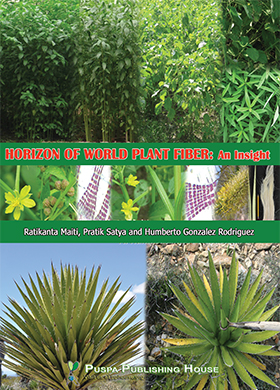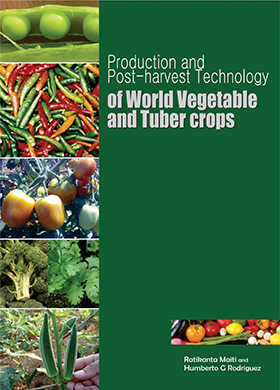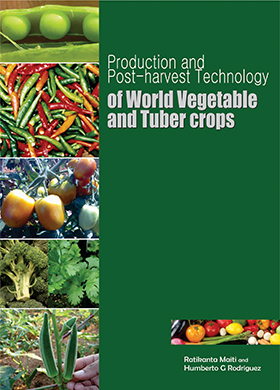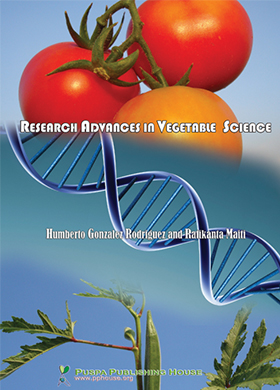Popular Article
Drip Irrigation in Castor Enhances Bean Yield, Saves Water and Increases Profitability
V. Praveen Rao, G. Suresh, A. V. Ramanjaneyulu and V. Anitha
- Page No: 048 - 053
- Published online: 18 Jun 2021
-
Abstract
velchalap@gmail.com
The castor growers are compelled to obtain low yields (500-600 kg ha-1) and returns leading to crop shift due to various abiotic and biotic stresses in rainfed castor. But there is a dire need to enhance castor yields as the global castor oil market is expected to touch $1,470 million by the end of 2025 due to its wide-ranging applications in the specialty chemical industry. We found that growing castor in winter season combined with drip irrigation and fertigation presents an excellent opportunity for enhancing bean yield, profits and saving scarce water resources. The discounted cash flow analysis suggested that, the investment on drip system in castor can be recovered in an year (two crop seasons without any subsidy). The PMKSY (Pradhan Mantri Krsihi Sinchayee Yojana) at country level and subsidies between 50 to 90% in Telangana State may encourage farmers in largescale adoption of drip irrigation in castor.
Keywords : Castor, crop water requirement, drip irrigation, water saving
-
Introduction
Castor (Ricinus communis L.) is one of the oldest cultivated non-edible oilseed crops of India. Castor oil, produced from its seeds has tremendous potential as an industrial feedstock for the global specialty chemical industry because of its high oil content (more than 488 g kg-1), unique hydroxylated fatty acid composition (900 g kg-1 of ricinoleic acid), potentially high oil yields (1796-2088 kg ha-1) and ability to be grown under marginal soils, drought and saline conditions. Gujarat is the top castor producing state in the country while Rajasthan, Andhra Pradesh and Telangana are other leading producers. The global castor oil market is estimated at $1,180 million in 2018 and is expected to touch $1,470 million by the end of 2025, growing at a CAGR of 2.8% between 2019 and 2025. India exports castor oil to China, Japan, Europe and the US.
Although, traditionally the Southern Telangana districts are major castor growing areas during kharif, the combination of coarse textured soils with low water holding capacity, periodic mid-season and terminal drought spells, frequent crop failures due to severe infestation of Botryotinia gray rot during the growing season (June to October) proved to be limiting the yields and profits. Alternatively, growing castor during winter season would provide optimal conditions for growth and production and when combined with drip irrigation and fertigation can achieve highest yields (Kumar et al., 2013a). Scientific drip irrigation scheduling is required because castor produces a low seed yield under low water availability, despite being highly drought tolerant. It is necessary to quantify seasonal and daily crop water use in terms of crop evapotranspiration (ETc) for that particular agro-climatic conditions. Hence, we present the results of series of field experiments conducted both at Water Technology Centre, Hyderabad and Regional Agricultural Research Station, Palem, to develop scientific irrigation scheduling protocols for drip irrigated castor to optimize water use and yields.
-
Why Drip Irrigation in Castor
Drip irrigation of horticultural crops such as vegetables, spices, fruits, orchard and plantation crops has been increasing since its introduction in India in 1980s. Similarly, field application of surface and subsurface drip in sugarcane and cotton also is being promoted in the states of Punjab, Gujarat, Maharashtra, Tamilnadu, Karnataka, etc. Major reasons for this conversion from surface gravity irrigation to drip irrigation are precision placement of water and fertilizer in the crop root zone, improved water application and fertilizer use efficiency and the resultant water and fertilizer savings, improved crop yields and profits, quality of produce, earliness etc., These features increase efficient agricultural water use, input use, irrigation coverage, agricultural production and address environmental concern by minimizing nitrate leaching. However, field studies are meagre on drip-irrigation scheduling for castor raised during winter season with respect to drip design module, seasonal and daily ETc, water savings, crop yields and decision criteria viz., production costs, net present value, net cash flow, payback period, and breakeven point for yield and price. These are limiting its large scale promotion (Rao, 2011).
-
Drip Irrigation Design Module for Castor
The drip irrigation system for castor consisted of head control unit including electric motor for pumping water at desired pressure, backflow prevention device such as non-return valve, air release valve for ejecting trapped air for smooth flow of water in irrigation pipes, vacuum breaker to prevent siphoning water back, filtration unit consisted of primary sand filter and secondary disc filter, fertilizer injector, throttle valve for flow control, pressure gauge and water meter for measuring volume of water during irrigation scheduling; Water carrier system including uPVC main pipeline, uPVC submain pipeline, control valve, flush valve and other fittings for carrying water from source to the field block; and Water distribution system including integral dripline with molded emitters, grommet, start connecter, nipple and end cap for delivering water in the crop root zone. The water source for drip irrigation was from an open well. Increasing the spacing of dripline laterals is one of the most important factors in reducing the high investment costs of drip irrigation system. Crop type, row spacing, soil type, and the reliability and amount of in-season rainfall are probably the major factors that determine the maximum dripline spacing. Careful attention to proper dripline spacing is, therefore, a key factor in conserving water, maintaining yields, protecting water quality and optimizing system costs.
Typically, one non-compensating integral dripline of 16 mm diameter laid out parallel to the castor rows on soil surface at 1.2 m apart feeding each crop row was most economical and enabled to achieve better water application uniformity, uniform crop stands, higher castor bean yields, and greatest water productivity under both Hyderabad and Palem agroclimatic conditions (Figure 2).
Driplines placed on the surface left slightly loose and properly aligned parallel to crop rows produce desired uniform wetting pattern. However, an emitter spacing of 40 cm at Palem and 50 cm at Hyderabad was found appropriate for castor depending on the soil texture i.e., sandy loam and sandy clay loam soils, respectively. The emitter spacing may be adjusted, if required in new areas depending on the soil texture to achieve the appropriate application rate to meet the peak crop water needs. Emitter flow rate ranging from 2 to 4 litres hour-1 were found to be adequate depending upon the soil infiltration rate, application rate desired to satisfy the peak crop water use, water quality, soil salinity and the water availability. The water application rate for drip irrigated castor was 4.16 mm hour1 at Palem and 6.66 mm hour-1 at Hyderabad. Desired wetting patterns on varied soil textures can be obtained by selecting the appropriate combination of emitter flow rate and emitter spacing.
-
Estimation of Crop Water Requirements
Seasonal and daily water use in drip irrigated castor field can be quantified as the summation of evaporation from the soil surface (E) and crop transpiration (Tc) which are combinedly termed as crop evapotranspiration, Etc (Rao and Raikhelkar, 1994). The ETc was estimated (ETc = ETo x Kc) using reference crop evapotranspiration (ETo) derived from local meteorological data and crop coefficient (Kc) factor (Figure 3). The Kc is dependent upon region specific crop characteristics including albedo, crop height, aerodynamic properties, irrigation and was experimentally derived (Kc = ETc÷ETo) for Hyderabad conditions (Rao and Raikhelkar, 1993). Since, it is a dimensionless ratio and characteristic of crop, it is transferable across locations. Only ETo is needed at new location for calculating castor ETc. The Kc value varies with developmental stages of castor and reflects the different water use requirements of the crop as it grows and matures (Figure 3) based on the prevailing weather conditions viz., temperature, solar radiation, humidity and wind velocity as reflected by ETo (Kumar et al., 2013b).
Initially the Kc was low due to incomplete canopy cover (Leaf area index = 0.068 to 0.651) reflecting that most of the water loss may constitute evaporation from bare soil (1.3 mm day-1), while germination, emergence and establishment of the crop took place. With advancement of crop age through vegetative, flowering, capsule setting and capsule development stages, the Kc increased linearly reflecting the increased water loss (1.5 to 2.64 mm day-1) due to increasing transpiring surface as a consequence of rapid leaf area development (LAI =1.5) and its persistence i.e., leaf area duration (LAD = 26.5 m2 days). During capsule setting and capsule development period the Kc reached a peak value of 1.06 indicating the peak water requirement of the crop (3.13 mm day-1) as a consequence of full canopy cover (LAI = 2.60) and its persistence (LAD = 42.3 m2 days) intercepting maximum photosynthetically active incident radiation. Over the penultimate crop growth sub-period of leaf drying and maturity the Kc precipitously dropped to a low value of 0.33 due to leaf senescence and possibly due to reduced root activity.
The Kc value also indicates the relative difference in water use between the crop and the evaporative demand of the atmosphere quantified through reference ETo value; for example, a Kc value of 1.06 indicates that the crop is using more water than that of the reference crop while Kc values below 1.0 indicate that the crop is using less water. For ETo, calculations vary between location, season, the ET model used, and the reference crop chosen. Commonly, ETo is determined using meteorological methods for a reference grass surface having 0.12 m height which is adequately-watered, actively growing, completely shading the ground, and with a fixed surface resistance that are utilized in the Penman–Monteith model for the actual calculation of ETo.
-
Castor Water Use – Drip Versus Surface Irrigation
A major attribute of drip irrigation is its ability to deliver water directly to the plant roots consistently in small amounts at the required amount and timing (Rao, 2018). This enables accurate irrigation water management according to the crop’s varying requirements across crop development stages without any wastage. This advantage is clearly demonstrated through a marked reduction in seasonal irrigation water needs of castor under drip when compared to conventional surface method of irrigation. The seasonal irrigation water use under drip was 22.13%, 33.22% and 39.78% less at Rajendranagar, Palem and Narkhoda, respectively, with an average of 31.71%, over surface irrigation method (Figure 4).
This reduction was primarily associated with the reduction in non-beneficial components of water balance viz., elimination of conveyance and seepage losses from source to field, minimal soil evaporation, no in-field runoff and negligible in-season deep percolation losses (Kumar et al., 2013b). This is expected because the field application efficiency of a drip system can approach 90-95% when compared with surface method of irrigation that typically operates at only 50-60% application efficiency. Indeed, these water savings are similar to local farmer’s anecdotal reports of 25-50% irrigation water savings in vegetable and fruit crops with drip irrigation compared with surface method of irrigation (Rao et al., 2014; Rao and Ramulu, 2018).
-
Yield and Economic Analysis – Drip Versus Surface Irrigation
Utilizing drip irrigation technology has the potential to measurably increase castor bean yields and expand irrigated acreage in water scarce situations, thereby increasing the farm profitability. Thus, in diverse agroclimatic conditions of Telangana State consistently surface drip irrigation produced superior castor performance and resulted in greater bean yields by 67.77%, 39.41% and 77.31% at Rajendranagar, Palem and Narkhoda, respectively, with an average of 69.41% (Figure 5) over conventional method of irrigation (Patel et al., 2004; Kumar et al., 2013a).
Comparison of relative production costs of two methods of irrigation indicated that the cost of production under drip method of irrigation is less by 8.7% when compared to surface method of irrigation. Cost reduction was generally noticed in labour intensive operations such as weed control, irrigation scheduling and associated electricity charges and plant protection.
One deterrent to establishing surface drip irrigation over current surface method of irrigation system by farmers is the high fixed cost of drip system installation. However, drip irrigation systems have been shown to be competitive with other irrigation systems when the value of crop grown, system longevity, and other environmental and management concerns are taken into account. To what extent this discouragement effect is real and to what extent such effect can be counterbalanced by government subsidy are important policy issues requiring empirical answers. Therefore, in order to find out the economic viability of drip investment in the context of castor crop, the decision criteria such as net present value (NPV), net cash flow, payback period, breakeven point for yield and price were computed by utilising the discounted cash flow technique (Table 1). The NPV is the difference between the sum of the present value of cash inflows and the costs over a given life period (10 years) of the drip system and it collates the total cash flows with the total costs covering items like fixed capital and depreciation costs of the drip system.
The gross income of drip irrigated castor was markedly higher (Rs. 1,28,400 ha-1) than surface method of irrigation (Rs. 76,500 ha-1) (Patel et al., 2010). Although, the NPV of both the methods of irrigation is positive, the NPV of drip irrigated castor was markedly greater (by 67.5%) than surface method of irrigation suggesting that the discounted present value of all future cash flows related to drip would be much attractive. Therefore, in terms of the NPV criterion, the investment on drip irrigation system in castor can be treated as economically viable.
The breakeven point (BEP) for price indicated that the profitability of castor was achieved above Rs. 9.98 and Rs. 10.02 kg-1 selling price under surface and drip method of irrigation, respectively. Similarly, BEP for yield suggested that profitability of castor was achieved above 33.21% and 33.43% of castor bean yield plugged each year in surface and drip method of irrigation, respectively. Further, the important issue in the context of drip irrigation adoption in castor is the number of years needed to recover the full capital costs involved in drip installation. The economic results further indicate the capital investment on drip irrigation system in castor can be recovered with in a period of one year i.e., two crop seasons without factoring any subsidy (Rao, 2011).
-
Conclusion
Growing castor in post monsoon season with drip irrigation and fertigation resulted in greater bean yield ranging from 39.4 to 67.7%, water saving by 22.1 to 33.2% and reduced the production costs by 8.7%, vis-à-vis traditional methods. The integral driplines at 1.2 m apart parallel to crop rows, emitters at 40 cm spacing with a flow rate of 2 litres hour-1 was technically appropriate. Farmers need to be encouraged for largescale adoption of drip irrigation in castor.
Figure 1: Drip irrigation in castor
Figure 2: Physical arrangements of the surface dripline in relation to the drip irrigated castor grown at 1.2 m spacing
Figure 3: Field irrigation schedule for drip irrigated castor under Hyderabad agroclimatic conditions
Figure 4: Water use by castor – Drip versus surface irrigation
Figure 5: Castor bean yield – Drip versus surface irrigation
Table 1: Drip Vs. surface irrigated castor - Detailed cash flow
Figure 1: Drip irrigation in castor
Figure 2: Physical arrangements of the surface dripline in relation to the drip irrigated castor grown at 1.2 m spacing
Figure 3: Field irrigation schedule for drip irrigated castor under Hyderabad agroclimatic conditions
Figure 4: Water use by castor – Drip versus surface irrigation
Figure 5: Castor bean yield – Drip versus surface irrigation
Table 1: Drip Vs. surface irrigated castor - Detailed cash flow
Figure 1: Drip irrigation in castor
Figure 2: Physical arrangements of the surface dripline in relation to the drip irrigated castor grown at 1.2 m spacing
Figure 3: Field irrigation schedule for drip irrigated castor under Hyderabad agroclimatic conditions
Figure 4: Water use by castor – Drip versus surface irrigation
Figure 5: Castor bean yield – Drip versus surface irrigation
Table 1: Drip Vs. surface irrigated castor - Detailed cash flow
Figure 1: Drip irrigation in castor
Figure 2: Physical arrangements of the surface dripline in relation to the drip irrigated castor grown at 1.2 m spacing
Figure 3: Field irrigation schedule for drip irrigated castor under Hyderabad agroclimatic conditions
Figure 4: Water use by castor – Drip versus surface irrigation
Figure 5: Castor bean yield – Drip versus surface irrigation
Table 1: Drip Vs. surface irrigated castor - Detailed cash flow
Figure 1: Drip irrigation in castor
Figure 2: Physical arrangements of the surface dripline in relation to the drip irrigated castor grown at 1.2 m spacing
Figure 3: Field irrigation schedule for drip irrigated castor under Hyderabad agroclimatic conditions
Figure 4: Water use by castor – Drip versus surface irrigation
Figure 5: Castor bean yield – Drip versus surface irrigation
Table 1: Drip Vs. surface irrigated castor - Detailed cash flow
Figure 1: Drip irrigation in castor
Figure 2: Physical arrangements of the surface dripline in relation to the drip irrigated castor grown at 1.2 m spacing
Figure 3: Field irrigation schedule for drip irrigated castor under Hyderabad agroclimatic conditions
Figure 4: Water use by castor – Drip versus surface irrigation
Figure 5: Castor bean yield – Drip versus surface irrigation
Table 1: Drip Vs. surface irrigated castor - Detailed cash flow
Reference
-
Kumar, B.R., Rao, V.P., Ramulu, V., Kumar, K.A., 2013a. Drip irrigation schedule for castor based on pan evaporation. Journal of Research ANGRAU 41, 149−152.
Kumar, B.R., Rao, V.P., Ramulu, V., Devi, M.U., Kumar, K.A., Rao, P.R., 2013b. Crop coefficients for prediction of evapotranspiration and irrigation requirements of drip irrigated castor (Ricinus communisL.). Journal of Oilseeds Research 30, 90−92.
Rao, V.P., Raikhelkar, S.V., 1994. Evapotranspiration of sesame in relation to pan evaporation. Indian Journal of Agricultural Sciences 64, 771−774.
Rao, V.P., Raikhelkar, S.V., 1993. Model for characterizing the effect of evaporative demand, canopy cover and soil water on sesame evapotranspiration. Journal of Oilseeds Research 10, 112−115.
Rao, V.P., Rao, P.R., Ramanjaneyulu, A.V., 2014. Microirrigation technology for improved and sustainable crop production. In: Rodriguez, H.G., Sarkar, N.C., Ramanjaneyulu, A.V. and Maiti, R.K. (Eds.), Advances in Agro-technology, Volume II, 166-202, Puspa Publishing House, 50/2, Central Road, Kolkata, India - 700 122.
Rao, V.P., 2018. Doubling Farmers Income Drip irrigation – An efficient tool to achieve the goal. In: Lead papers of XXI Biennial National Symposium “Doubling farmers’ income through agronomic interventions under changing scenario”, Indian Society of Agronomy, IARI, New Delhi 110 012, 17−20.
Rao, V.P., Ramulu, V., 2018. Telangana State Microirrigation Project – A special purpose vehicle to avert water scarcity and enhance yield, incomes and environmental sustainability. Publication No. 107/MG/PJTSAU/2018, ISBN 978-81-936934-3-8, Professor Jayashankar Telangana State Agricultural University, Rajendranagar, Hyderabad 500030, Telanganana, India, 23.
Patel, K.S., Patel, P.G., Patel, G.N., Patel, J.K., Pathak, H.C., 2004. Feasibility of drip irrigation in castor (Ricinus communisL.,) under sandy loam soil of North Gujarat. Journal of Oilseeds Research 21, 194−195.
Patel, R.A., Patel, J.J., Patel, A.S., 2010. Seed yield and net returns of drip irrigated late Kharif castor (Ricinus communisL.,) as influenced by plant geometry and nitrogen levels. International Journal of Agricultural Sciences 6, 449−452.
Rao, V.P., 2011. Drip irrigation of castor pays. AgroNet News Letter 55, NetafimYiftah, Israel.
Cite
Rao, V.P., Suresh, G., Ramanjaneyulu, A.V., Anitha, V. 2021. Drip Irrigation in Castor Enhances Bean Yield, Saves Water and Increases Profitability . Chronicle of Bioresource Management. 5,1(Jun. 2021), 048-053. DOI:.
Rao, V.P.; Suresh, G.; Ramanjaneyulu, A.V.; Anitha, V. Drip Irrigation in Castor Enhances Bean Yield, Saves Water and Increases Profitability . CBM 2021,5, 048-053.
V. P. Rao, G. Suresh, A. V. Ramanjaneyulu, and V. Anitha, " Drip Irrigation in Castor Enhances Bean Yield, Saves Water and Increases Profitability ", CBM, vol. 5, no. 1, pp. 048-053,Jun. 2021.
Rao VP, Suresh G, Ramanjaneyulu AV, Anitha V. Drip Irrigation in Castor Enhances Bean Yield, Saves Water and Increases Profitability CBM [Internet]. 18Jun.2021[cited 8Feb.2022];5(1):048-053. Available from: http://www.pphouse.org/cbm-article-details.php?cbm_article=30
doi = {},
url = {},
year = 2021,
month = {Jun},
publisher = {Puspa Publishing House},
volume = {5},
number = {1},
pages = {048--053},
author = { V Praveen Rao, G Suresh, A V Ramanjaneyulu , V Anitha and },
title = { Drip Irrigation in Castor Enhances Bean Yield, Saves Water and Increases Profitability },
journal = {Chronicle of Bioresource Management}
}
DO -
UR -
TI - Drip Irrigation in Castor Enhances Bean Yield, Saves Water and Increases Profitability
T2 - Chronicle of Bioresource Management
AU - Rao, V Praveen
AU - Suresh, G
AU - Ramanjaneyulu, A V
AU - Anitha, V
AU -
PY - 2021
DA - 2021/Jun/Fri
PB - Puspa Publishing House
SP - 048-053
IS - 1
VL - 5
People also read
Scientific Correspondence
Crop Residue Management in Cotton
A. V. Ramanjaneyulu, B. Ramprasad, N. Sainath, E. Umarani, Ch. Pallavi, J. Vijay and R. JagadeeshwarCotton residue, burning, pollution, management, multicrop shedder
Published online: 04 Mar 2021
Popular Article
Sustainable Rice Production in India Through Efficient Water Saving Techniques
S. Vijayakumar, V. Karunakaran, R. Gobinath, K. Basavaraj, B. Raghavendra Goud, Naseeruddin Sha, Vakada Manasa and S. AravindanRice, Perception, Problems, Water-smart technologies, DSR
Published online: 31 Mar 2022
Popular Article
Broomrape (Orobanche sp.) Management in Indian Mustard
Tanmay Das, Teekam Singh and Prakash SonnadBroomrape, mustard, parasitic weeds
Published online: 28 Mar 2023
Popular Article
Pulses - Boon for Human and Soil Health
M. Ranjith and S. SrideviClimate change, nutrition, pulses, soil health, GHG emissions
Published online: 21 Jun 2021
Popular Article
Black Rice Cultivation in India – Prospects and Opportunities
Sanjoy Saha, S. Vijayakumar, Sanjana Saha, Ashirbachan Mahapatra, R. Mahender Kumar and R. M. SundaramAnthocyanin, Black rice, Forbidden rice, Nutritional value, Prospects
Published online: 27 May 2022
Structure and Floristic Compositions of Ecosystems of Northeast of Mexico
Foroughbakhch Rahim and Ngangyo Heya MaginotPublished online: 07 Jun 2017
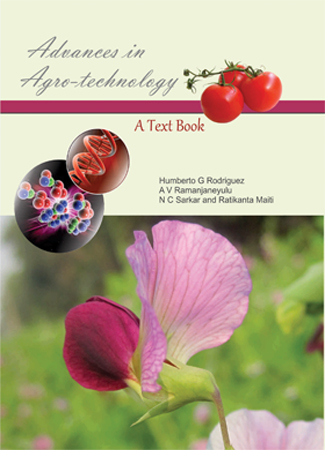
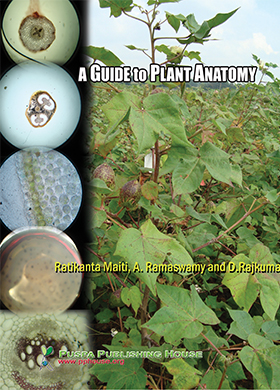
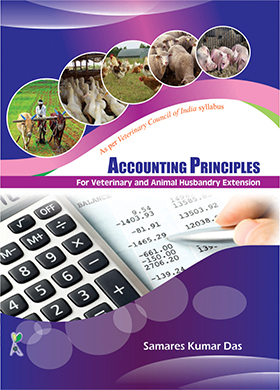
.jpg)
.jpg)


